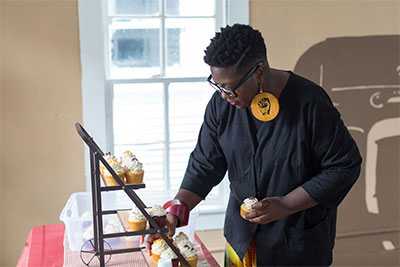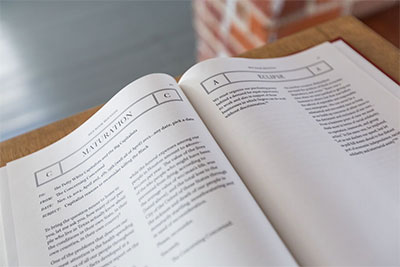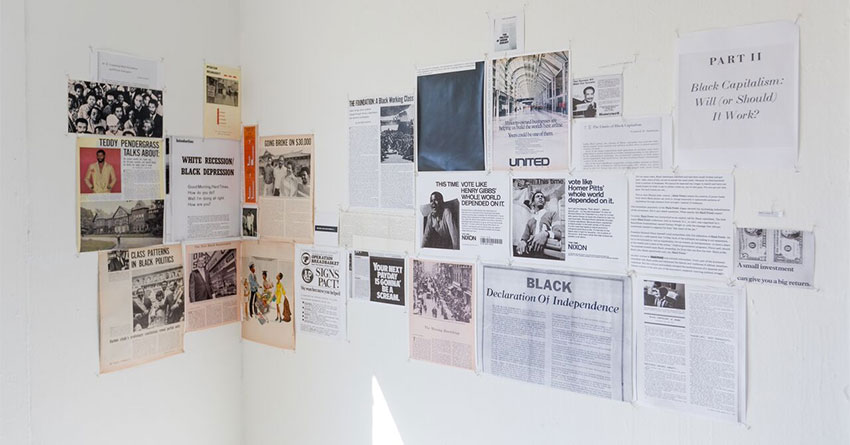Kameelah Janan Rashad, Manifestos & Manuals: A Reading/Publishing/Think Lab.
Courtesy Project Row Houses. Photo by Alex Barber.
Round 43 at Project Row Houses

On view through February 28, Project Row Houses’ most recent exhibition of visual art and social practice explores the intersection of race and economics. Entitled Small Business/Big Change: Economic Perspectives from Artists and Artrepreneurs, this 43rd Round of art from PRH is exhibited in a row of renovated shotgun-style houses, transforming them into seven small businesses, libraries, learning centers, and installation spaces. Featuring work by both artists and artisans, Small Business/Big Change is an ambitious exhibition, exploring its themes through conceptual, practice-based, and text-based content as often as it does though imagery. Through a diverse and often weighty reflection on history, theory, and contemporary culture, several spaces and individual works resound throughout the exhibition with particularly strong aesthetic and conceptual voices.
Perhaps the most intimate of the Round 43 installations is that of Houston artist Charisse Weston. Her work The Red Book of Houston: A Compendium of the New Black Metropolis reimagines a 1915 book of a similar name, which sought to document the city’s successful models of Black prosperity. Placed among handcrafted study niches, Weston’s book explores race and economics through samples of historical and academic text, fiction, internal narrative, and poetry. Weston’s installation also offers a focus on African American women that is unique within the round. In a chapter entitled Origins, a sample of academic text notes that, historically, black women have been expected to unite and uplift their communities. While at least one of Weston’s fictional narrators can be characterized as a dedicated breadwinner, others are better identified by their self-described quiet insight—their abilities to observe (and occasionally react to) personal economic or social turmoil. These women write of silence, but, on the page, they (and Weston) have a voice—even if it is one caught up in the midst of gender and racial inequality.

One of the most visually poignant elements in this exhibition is the pair of impossibly long braids of hair that appear in the site-specific installation Supply. Created by Martine Syms with Diamond Stingly, Supply was designed to recall local beauty supply shops, and to facilitate the exploration of black style’s politics and economics. Surrounded by displays of African American beauty products and Xeroxed collages of product packaging, the brown braids are attached at eye-level on adjacent walls. Approximately fifteen-feet long, they trail down onto the floor and meander toward the center of the room, almost pointing to the building’s door. At such an incredible length, these bobble- and barrette-adorned cords of hair are playfully surreal. Overall, their display suggests a mixture of strength and vulnerability, beauty, and autonomy.
Another compelling component of Small Business/Big Change is the poetic collage featured in Kameelah Janan Rashad’s Manifestos & Manuals: A Reading/Publishing/Think Lab, an installation that explores African American self-help rhetoric. Rasheed’s assemblage of text and photographs wraps most of the house’s space at eye-level and samples from a myriad of sources including Black Enterprise and EBONY magazines, the writings of W.E.B. Du Bois and Booker T. Washington, Richard Nixon’s Black Capitalism campaign, and a range of academic texts on Black Capitalism. Juxtaposing items such as articles about black CEOs and celebrities, personal photographs of black families, and advertisements regarding credit card debt, Kameelad creates a thoughtfully layered psychological space of mixed messages that is worthy of investigation.
Finally, Crumbville Texas General Store is the temporary storefront for Ella Russell’s self-run baked-goods business E-dub-a-licious. Designed in collaboration with artist Anthony Suber, the installation is a contemporary take on the historical general store, and features antique-inspired furnishings and an ample display of cupcakes and cookies. However, the real spirit of the space comes from Ella Russell herself, who can be found at the store register, distributing samples, engaging with her customers, and sharing her passion for her craft. In addition to being an opportunity for a small business owner to expand her visibility and clientele, Crumbville is an interesting moment of specific economic tangibility in an exhibition immersed in theory, visual expression, and social practice.
Overall, Round 43: Small Business/Big Change features contributions from Ella Russell in collaboration with Anthony Suber; Shani Peters; Kameelah Janan Rashad; Nsenga Knight; Charisse Weston; Martine Syms in collaboration with Diamond Stingly; and Fredia Mitchell. By engaging this array of artists and makers, PRH has curated a worthwhile round table discussion on race and economics in America.
-ALEXANDRA IRRERA

